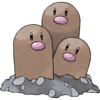Ecologically similar Pokémon: Difference between revisions
Tiddlywinks (talk | contribs) m (が is "but") |
(elevating trivium; rewording) |
||
| Line 2: | Line 2: | ||
Certain {{OBP|Pokémon|species}} are described as '''ecologically similar'''<ref name=SVsite>[https://scarletviolet.pokemon.com/en-us/pokemon/poltchageist/ Poltchageist — Pokémon Scarlet and Pokémon Violet | Official Website].</ref> (Japanese: '''生態は似ている'''<ref>[https://www.pokemon.co.jp/ex/sv_dlc/ja/pokemon/230822_01/ チャデス|『ポケットモンスター スカーレット・バイオレット ゼロの秘宝』公式サイト]</ref> ''ecologically similar'') to previously discovered species, but are otherwise completely different Pokémon. This concept was first introduced in [[Generation IX]]. | Certain {{OBP|Pokémon|species}} are described as '''ecologically similar'''<ref name=SVsite>[https://scarletviolet.pokemon.com/en-us/pokemon/poltchageist/ Poltchageist — Pokémon Scarlet and Pokémon Violet | Official Website].</ref> (Japanese: '''生態は似ている'''<ref>[https://www.pokemon.co.jp/ex/sv_dlc/ja/pokemon/230822_01/ チャデス|『ポケットモンスター スカーレット・バイオレット ゼロの秘宝』公式サイト]</ref> ''ecologically similar'') to previously discovered species, but are otherwise completely different Pokémon. This concept was first introduced in [[Generation IX]]. | ||
They are often referred to by fans as '''convergent forms''', '''convergent Pokémon''', or '''convergent species''', relating the concept to {{wp|convergent evolution}} in biology. They have also been referred to as '''regional fakes''', due to comparisons to the similar concept of [[regional form]]s. So far, five of these Pokémon have been introduced. [[Jacq]] is known for his research on these Pokémon in collaboration with the World Pokémon Ecological Society.<ref name=WPES>[https://wpes.pokemon.co.jp/en/ World Pokémon Ecological Society] ([https://www.youtube.com/watch?v=pQoVAMGli0E Video archive])</ref> | They are often referred to by fans as '''convergent forms''', '''convergent Pokémon''', or '''convergent species''', relating the concept to {{wp|convergent evolution}} in biology. They have also been referred to as '''regional fakes''', due to comparisons to the similar concept of [[regional form]]s, which are different forms of the same Pokémon. So far, five of these Pokémon have been introduced. [[Jacq]] is known for his research on these Pokémon in collaboration with the World Pokémon Ecological Society.<ref name=WPES>[https://wpes.pokemon.co.jp/en/ World Pokémon Ecological Society] ([https://www.youtube.com/watch?v=pQoVAMGli0E Video archive])</ref> | ||
==History== | ==History== | ||
| Line 48: | Line 48: | ||
==Trivia== | ==Trivia== | ||
* These Pokémon are similar to the [[Paradox Pokémon]] in that they bear a striking resemblance to certain Pokémon but are nonetheless completely different species. | * These Pokémon are similar to the [[Paradox Pokémon]] in that they bear a striking resemblance to certain Pokémon but are nonetheless completely different species. | ||
* {{p|Poltchageist}} and {{p|Sinistea}} are the only ecologically similar Pokémon that share a [[type]]. | * {{p|Poltchageist}} and {{p|Sinistea}} are the only ecologically similar Pokémon that share a [[type]]. | ||
* {{p|Wiglett}} | * The concept of ecologically similar Pokémon was first introduced with the reveal of {{p|Wiglett}} before the release of {{g|Scarlet and Violet}}.<ref name=WPES/> | ||
===Origin=== | ===Origin=== | ||
Revision as of 03:54, 24 August 2023

|
The subject of this article has no official name. The name currently in use is a fan designator; see below for more information. |
Certain Pokémon are described as ecologically similar[1] (Japanese: 生態は似ている[2] ecologically similar) to previously discovered species, but are otherwise completely different Pokémon. This concept was first introduced in Generation IX.
They are often referred to by fans as convergent forms, convergent Pokémon, or convergent species, relating the concept to convergent evolution in biology. They have also been referred to as regional fakes, due to comparisons to the similar concept of regional forms, which are different forms of the same Pokémon. So far, five of these Pokémon have been introduced. Jacq is known for his research on these Pokémon in collaboration with the World Pokémon Ecological Society.[3]
History
These Pokémon were first identified by the World Pokémon Ecological Society after the discovery of Wiglett during a survey.[3] Wiglett was initially mistaken as a possible Paldean form of Diglett before it was decided that it was a different species entirely and the similarities were merely coincidental.
In the games
In Pokémon Scarlet and Violet, the player can find Pokémon that are ecologically similar to other species across Paldea, as well as in Kitakami.
List of ecologically similar Pokémon
| Ecologically Similar Pokémon | ||||
|---|---|---|---|---|
| Ndex | Newer Pokémon | Ndex | Original Counterpart | |
| #0948 |  Toedscool Ground Grass |
#0072 |  Tentacool Water Poison | |
| #0949 |  Toedscruel Ground Grass |
#0073 |  Tentacruel Water Poison | |
| #0960 |  Wiglett Water |
#0050 |  Diglett Ground | |
| #0961 |  Wugtrio Water |
#0051 |  Dugtrio Ground | |
| #??? |  Poltchageist Grass Ghost |
#0854 |  Sinistea Ghost | |
Trivia
- These Pokémon are similar to the Paradox Pokémon in that they bear a striking resemblance to certain Pokémon but are nonetheless completely different species.
- Poltchageist and Sinistea are the only ecologically similar Pokémon that share a type.
- The concept of ecologically similar Pokémon was first introduced with the reveal of Wiglett before the release of Pokémon Scarlet and Violet.[3]
Origin
While these Pokémon are officially described as "ecologically similar"[1], it may be more accurate to describe them as "morphologically similar", as while they have similar physical characteristics, many of them occupy very different ecological niches. The concept has been compared to convergent evolution and parallel evolution in evolutionary biology, both of which can lead to separate organisms independently developing similar or identical characteristics and body plans.
In other languages

|
This section is incomplete. Please feel free to edit this section to add missing information and complete it. |
See also
References
| |||||||||||||||||||||||||||||||||||||||||||||||

|
This game-related article is part of Project Games, a Bulbapedia project that aims to write comprehensive articles on the Pokémon games. |